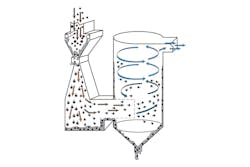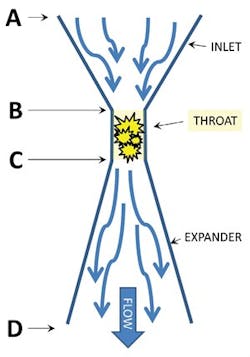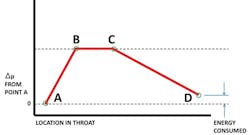Fans of the TV show The Big Bang Theory are familiar with the banter between the characters regarding the alleged superiority of physicists to engineers. One-liners delivered by physicist Dr. Sheldon Cooper purportedly boasting of a physicist’s intellectual superiority over engineers, such as “Engineering is merely the slow younger brother of physics,” are intended to provide humor. In all seriousness, however, the laws of physics dictate the formulas used by engineers to predict the performance of Venturi scrubbers for the removal of particulate matter (PM) from a gas stream.
In a Venturi scrubber, the collection object is a liquid drop. Its diameter is a complicated function of velocity, liquid rate and fluid properties. Normally, a centrifugal fan is installed upstream (forced draft) or downstream (induced draft) from the Venturi scrubber. The fan provides the motive force to the gas stream carrying the PM. The gas is accelerated to the throat velocity in the converging inlet. The gas then passes through the throat, where the PM encounters the liquid drops (obstacles).
The particles that impact liquid drops can be easily separated from the bulk of the gas stream by collecting them in a cyclonic (centrifugal) or chevron (impaction) mist eliminator. Particles that do not impact liquid drops “penetrate” the scrubber and are exhausted with the gas stream.
Some Venturi scrubbers are designed by well-intentioned engineers to shortcut these laws of physics in an effort to produce a competitive product. The laws of physics, however, require that a properly designed Venturi scrubber must include three critical elements: a converging inlet, a defined Venturi throat and an expander section. Whenever shortcuts in design exclude any of the three critical elements, the Venturi scrubber will be less effective and will consume excess energy without achieving the intended PM collection efficiency. This article highlights the important design factors for wet Venturi scrubbers and explains why shortcuts in design create Venturi scrubbers that are less effective at capturing PM.
Inlet
In the wetted approach Venturi scrubber as shown in Figure 1, the gas is introduced in a radial fashion and scrubbing liquid is provided to completely wet the inlet section. The gas is introduced in such a way that, once it leaves the inlet gas nozzle, it never contacts a dry wall. The only surfaces the gas can touch are already wetted with a liquid film so solids deposition does not occur.
Throat
Venturi scrubbers can be furnished as either fixed-flow or variable-flow devices. In the fixed-throat Venturi, gas flow must be constant to maintain a steady differential pressure and collection efficiency. In the variable-flow Venturi, the throat is adjustable. When reduced gas flow conditions are encountered, the position of the throat damper can be changed to hold constant differential pressure, and collection efficiency can be maintained.
The physical mechanisms affecting PM collection in Venturi scrubbers include inertia (inertial impaction), diffusion, electrostatics, Brownian motion, nucleation and growth, and condensation. While all of these mechanisms affect collection, the predominant phenomenon is inertial impaction.
When capturing a particle of a given diameter and density in a gas stream of a given viscosity, two main variables affect the collection efficiency (allowing, as stated earlier, that impaction is the predominant mechanism):
- Relative velocity between the gas and the collection object
- Characteristic dimension of the collection object
For inertial impaction to occur, the dust particle must run into a liquid droplet. How does this occur? Simply. The greater the relative velocities (momentum) between the dust particles relative to the liquid droplets, the greater probability that the dust particles will collide with the liquid droplets and be captured. To illustrate: Someone drives a car down a road, and the air is filled with flying insects. The faster the car travels, the more likely that insects will hit the windshield. In this analogy, the bugs are the dust particles, and the car is the liquid droplet (collector).
A Venturi is a well-known device for accelerating a fluid stream to a high velocity and returning it to its original velocity with a minimum loss of energy. This is why a Venturi is an integral component in high-velocity wind tunnels. It is therefore only natural that the Venturi was chosen as the most efficient method for contacting a gas and a liquid for maximum PM removal from the gas.
Liquid drops can be created in two different ways in the scrubber. The most common is simply to allow the high-velocity gas to atomize the liquid. This consumes some energy as fan horsepower. When these drops enter the throat area and encounter the high-velocity gas stream, they explode into thousands of smaller droplets (atomization).
The second method is to atomize the liquid using spray nozzles. In this case, the energy used to atomize the liquid is provided by pump horsepower. No substantial energy savings are realized by using either technique, but the high-pressure nozzle technique is limited to applications in which a clean liquid stream is fed to the Venturi, limiting its application when recirculating scrubber liquid.
Expander section
As the gas exits the scrubbing throat, it carries with it all the liquid droplets, which have now achieved a velocity nearly that of the gas stream (see Figure 2). In the expander section, the gas is slowed as the cross-sectional area increases. Some of the kinetic energy from the liquid droplets transfers back to the gas stream, resulting in a recovery of part of the energy required to accelerate the gas to throat velocity. This energy regain is what distinguishes a Venturi scrubber from any other type of wet scrubber. Once the gas has been slowed sufficiently to minimize additional turbulent losses, it is directed to a cyclonic separator/mist eliminator where it is separated from the gas stream.
The term “pressure drop” refers to the difference in static pressure between the gas at the inlet to the Venturi scrubber and the gas at the discharge from the Venturi scrubber. Figure 3 is a typical pressure profile for a Venturi scrubber. As the gas accelerates, the pressure in the gas stream decreases to its lowest point in the throat. As the gas begins to slow down in the expander section, pressure rises and reaches a level only slightly lower than the pressure at the inlet. The difference between A and D (inlet and outlet pressures), or the pressure drop, represents the energy expended in the scrubbing process. If the expander section is omitted, the energy expended is greater and shown as the difference between A and C.
The Calvert equation can be used to predict the actual pressure drop for a given throat velocity. The Calvert equation states:
At saturated conditions, the pressure drop is equal to the power required to accelerate the liquid to the gas velocity. This is not 100 percent accurate because it does not account for:
- Frictional losses in the Venturi
- The possibility that liquid is not accelerated to the full gas velocity
- When the liquid transfers momentum back to gas in the expander section
However, this calculation predicts pressure drop reasonably well except at very high liquid-to-gas ratios (L/G.) Most Venturi scrubbers are designed for an L/G between 7 and 10 gpm per 1,000 acfm, and virtually no change in performance occurs across this range of liquid rates when at a constant pressure drop across the scrubber. Lower L/G does not properly distribute liquid across the throat. Higher L/G wastes energy accelerating excess liquid with no collection efficiency benefit.
Venturi scrubber size
After the required pressure drop has been computed, the Venturi scrubber must be sized. Usually, all dimensions of the scrubber derive from the size of the scrubbing throat. Therefore, a designer can use either the Calvert equation or empirical velocity-versusdifferential-pressure curves for a given scrubber to size the throat for a given saturated gas flow rate. Note that using the saturated gas flow rate, rather than the hot inlet gas flow rate, is imperative for sizing the throat.
As a hot flue gas stream enters the throat, it is immediately quenched to its saturation temperature, and the flow rate is reduced substantially. If the throat were sized on the unsaturated hot gas flow rate, it would be far too large for most applications, and the required collection efficiency could not be achieved. A fan must also be selected which will handle the required gas flow rate. The fan is sized on the actual gas flow rate at the fan, not necessarily the saturated gas flow rate, particularly on the forced draft side. Finally, pumps, piping, duct work and tankage must also be designed to complement the design parameters of the Venturi scrubbing system.
For a given particle size and a given throat velocity, one can determine empirically the fraction of particles that will be collected by the Venturi scrubber. This represents the fractional efficiency for a given particle diameter. At a given throat velocity, if all empirical fractional efficiency points are plotted versus particle diameter, a collection efficiency curve for a given pressure drop or throat velocity is produced. Typically, collection efficiency curves are plotted for varying pressure drops rather than throat velocities because this provides information on fan requirements.
The importance of experience, testing & sampling
To design a Venturi scrubber properly for a specific application, previous experience with analogous applications, testing a Venturi scrubber on the source and/or conducting sufficient sampling of the source to determine the characteristics of the PM are required. With the particle size distribution and specific gravity of the PM to be removed from the gas stream, if collection efficiency curves as a function of particle diameter for given pressure drops are available, the fraction of PM that will pass through the scrubber without being collected can be calculated.
Manufacturers have developed their own design and sizing processes for their particular Venturi scrubbing systems. They involve predicting fractional removal efficiencies at various diameter and specific gravity particles. The fractional removal efficiencies are then plotted against a particle size distribution to determine the differential pressure required to achieve a desired overall PM removal efficiency for that application. Venturi scrubber systems often include auxiliary components – such as recirculation tanks, recirculation pumps, liquid treatment systems, forced draft or induced draft fans, and pre-wired controls and instrumentation.
A properly designed Venturi scrubber includes a converging inlet, a defined Venturi throat and an expander section as defined by physics. Shortcuts in design without all three critical design components create a Venturi scrubber that is not as effective, and excess energy is wasted without achieving the desired PM collection.
Back to Sheldon
Imagine two of the characters on The Big Bang Theory, Dr. Sheldon Cooper, physicist, and Howard Wolowitz, engineer, discussing Venturi scrubber physics and the engineering and design of a Venturi scrubber. Sheldon would be at his whiteboard explaining to Howard the formulas and calculations for particle removal efficiency in a Venturi. Howard would argue to Sheldon that shortcuts would need to be implemented to be priced competitively in the marketplace. Sheldon might say, “I have never said that you are not good at what you do. It’s just that what you do is not worth doing.”
Dwayne Sanders is an air pollution control professional who serves as scrubber product manager for Sly Inc. He is a degreed chemical engineer from Georgia Tech with more than 30 years of experience in the air pollution industry with expertise in wet scrubber applications. Sanders is a past U.S. Paralympic Cycling Team member. He may be reached at 800-334-2957, extension 506, or [email protected].




